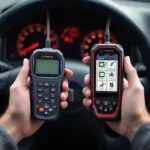Can OBD2 scan OBD1? This is a common question among car enthusiasts dealing with both older and newer vehicles. Understanding the key differences between these two diagnostic systems is crucial for effective troubleshooting. This article dives deep into the compatibility issues, exploring workarounds and solutions for accessing OBD1 data.
OBD1, or On-Board Diagnostics generation one, was introduced in the early 1980s and varied significantly between manufacturers. Unlike the standardized OBD2 system, OBD1 lacked a universal connector or communication protocol. This makes using an OBD2 scanner on an OBD1 vehicle directly impossible. They’re simply not designed to communicate with each other. Think of it like trying to plug a USB-C cable into a VGA port – the physical connection and data transfer methods are fundamentally different.
Understanding the OBD1 Landscape
OBD1 systems were primarily designed to monitor emissions-related components. They often relied on manufacturer-specific connectors and diagnostic trouble codes (DTCs). This meant mechanics needed specialized equipment for each car make and model. Some OBD1 systems didn’t even use a digital interface, instead relying on blinking check engine lights to communicate fault codes. Deciphering these codes often involved consulting complex manuals and counting flashes.
Why OBD2 Scanners Can’t Read OBD1 Directly
OBD2, implemented in 1996, standardized the diagnostic process. It mandated a universal 16-pin connector, a common communication protocol (ISO 9141-2, KWP2000, etc.), and a standardized set of DTCs. innova obd1 and obd2 scanner are designed to work within this framework. They cannot interpret the varied signals and protocols used by OBD1 systems.
Bridging the Gap: How to Access OBD1 Data
So, how can you access diagnostic information on an OBD1 vehicle? Several options exist, including:
-
Manufacturer-Specific Scan Tools: These tools are designed for a specific car make and model, allowing direct access to OBD1 data.
-
OBD1 Code Readers: Dedicated OBD1 code readers are available and provide a simpler, more affordable solution than full-blown manufacturer-specific scan tools.
-
Adapters and Conversion Cables: For some vehicles, actron cp9690 obd1 / obd2 scanner may be available. These connect the OBD2 scanner to the OBD1 port, converting the signals to a format the OBD2 scanner can understand. However, these adapters are not universally compatible and their effectiveness varies.
-
DIY Solutions: Experienced DIYers may be able to build their own interface cables and software to read OBD1 data using a computer. This requires a deep understanding of electronics and the specific OBD1 system in question.
What if I try to use an OBD2 scanner on an OBD1 port?
Attempting to force an OBD2 scanner into an OBD1 port or vice-versa can potentially damage both the scanner and the vehicle’s diagnostic system. It’s crucial to use the correct tools and procedures for each system.
reading obd1 codes with obd2 scanner often involves specific adapters and understanding the vehicle’s particular OBD1 system.
Choosing the Right Solution for Your Needs
The best approach depends on several factors, including the specific vehicle, your budget, and your technical expertise. For occasional use, a simple OBD1 code reader might suffice. For professional mechanics working on a range of older vehicles, investing in manufacturer-specific tools is often necessary.
“Understanding the limitations of your diagnostic equipment is essential. Using the wrong tool can lead to misdiagnosis and wasted time,” advises automotive diagnostic expert, Michael Stevens, ASE Certified Master Technician. He adds, “Investing in the correct equipment, whether it’s an OBD1 code reader, manufacturer-specific tool, or a compatible obd1 and obd2 code scanner, ensures accurate and efficient troubleshooting.”
Conclusion: Navigating the OBD1 and OBD2 Divide
While an OBD2 scanner cannot directly scan an OBD1 system, various solutions allow access to OBD1 diagnostic information. Choosing the right approach depends on your individual needs and the specific vehicle you’re working with. By understanding the key differences and available options, you can effectively diagnose and troubleshoot both OBD1 and OBD2 equipped cars. Remember that using the correct diagnostic tools is crucial for accurate results and avoiding potential damage.
FAQs
- Why is OBD2 standardized? To simplify diagnostics and ensure compatibility across different vehicle makes and models.
- Are all OBD1 systems the same? No, they vary significantly between manufacturers.
- Can I convert my OBD1 car to OBD2? This is complex and generally not recommended.
- Where can I find OBD1 diagnostic information for my car? Repair manuals and online resources specific to your vehicle’s make and model.
- What is the difference between a code reader and a scan tool? Code readers retrieve codes, while scan tools offer more advanced functionalities like live data viewing and bi-directional control.
- Is it worth investing in a professional-grade scan tool? If you work on cars regularly, a professional-grade tool is a valuable investment.
- What should I do if I get an error code? Consult a repair manual or seek professional assistance.
Need help with your car diagnostics? Contact us via WhatsApp: +1(641)206-8880, Email: [email protected] or visit us at 789 Elm Street, San Francisco, CA 94102, USA. Our 24/7 customer support team is ready to assist. You can also find more articles like innova 3140 scan obd1 obd2 scanner on our website.


